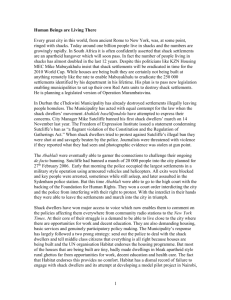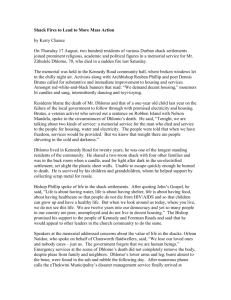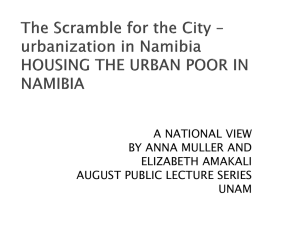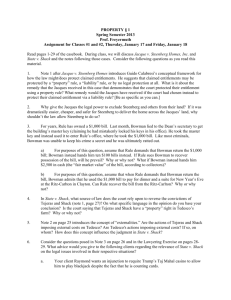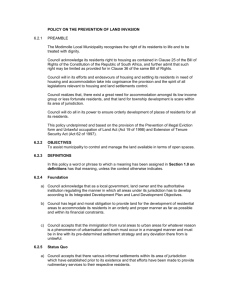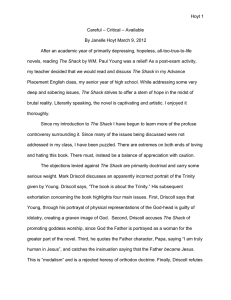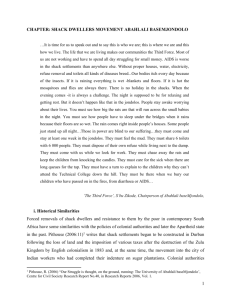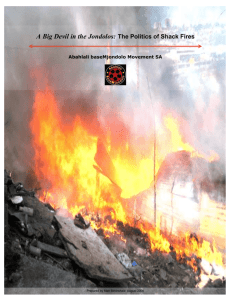Department of Politics and International Studies Political Sociology
advertisement
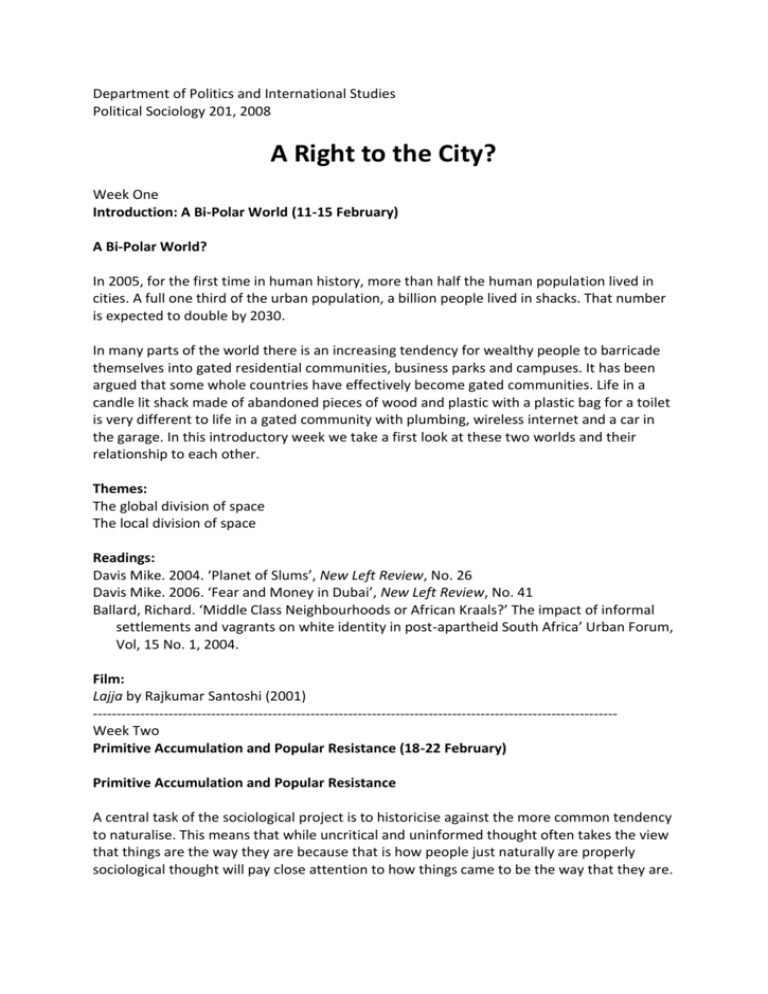
Department of Politics and International Studies Political Sociology 201, 2008 A Right to the City? Week One Introduction: A Bi-Polar World (11-15 February) A Bi-Polar World? In 2005, for the first time in human history, more than half the human population lived in cities. A full one third of the urban population, a billion people lived in shacks. That number is expected to double by 2030. In many parts of the world there is an increasing tendency for wealthy people to barricade themselves into gated residential communities, business parks and campuses. It has been argued that some whole countries have effectively become gated communities. Life in a candle lit shack made of abandoned pieces of wood and plastic with a plastic bag for a toilet is very different to life in a gated community with plumbing, wireless internet and a car in the garage. In this introductory week we take a first look at these two worlds and their relationship to each other. Themes: The global division of space The local division of space Readings: Davis Mike. 2004. ‘Planet of Slums’, New Left Review, No. 26 Davis Mike. 2006. ‘Fear and Money in Dubai’, New Left Review, No. 41 Ballard, Richard. ‘Middle Class Neighbourhoods or African Kraals?’ The impact of informal settlements and vagrants on white identity in post-apartheid South Africa’ Urban Forum, Vol, 15 No. 1, 2004. Film: Lajja by Rajkumar Santoshi (2001) --------------------------------------------------------------------------------------------------------------Week Two Primitive Accumulation and Popular Resistance (18-22 February) Primitive Accumulation and Popular Resistance A central task of the sociological project is to historicise against the more common tendency to naturalise. This means that while uncritical and uninformed thought often takes the view that things are the way they are because that is how people just naturally are properly sociological thought will pay close attention to how things came to be the way that they are. In this week we will begin to look at how some people were forced into a subordinate inclusion in the city. But in order to avoid the kind of historicisation that tends to focus on major social forces at the expense of the agency of ordinary people we’ll also look at how people resisted the forces that separated them from rural land and livelihoods. We’ll begin to get a sense of how the world is made by pressures from above and below. Themes: Land enclosure & proletarianisation Popular responses to proletarianisation Readings: Federici, Silvia. 2004. ‘All the world Needs a Jolt’ from Caliban and the Witch. New York. Autonomedia. Linebaugh, Peter and Rediker, Marcus. 1990. ‘The Many Headed Hydra: Sailors, Slaves and the Atlantic Working Class in the Eighteenth Century.’ Journal of Historical Sociology Vol. 3, No.3. Bradford Helen. 1998. ‘Master and Servants: The South African Coutnry Side, 1920-1930’ from A Taste of Freedom: The ICU in Rural South Africa 1924-1930. Johannesburg. Ravan Press. Film: Land and Freedom by Ken Loach (1995) --------------------------------------------------------------------------------------------------------------Week Three The Colonial City (25-29) The Colonial City Almost all of the major cities and towns in South Africa, including of course Grahamstown, continue to carry their colonial history in their basic structure. We need to understand the colonial city to understand the contemporary city. But some people argue that it is also essential to understand the colonial city because some colonial practices still shape the present. Themes: Colonial Manicheanism Shacks in South Africa Women shack dwellers’ Resistance to apartheid Readings: Fanon, Frantz. 1976. ‘On Violence’ from The Wretched of the Earth. London. Penguin Maylam, Paul. 1983. ‘Black Squatters in Durban 1935-1950’. Canadian Journal of African Studies. Vol. 17 No.3. Edwards, Iain. 1996. ‘Cato Manor, June 1959: Men, Women, Crowds, Violence, Politics and History’ in The People’s City: African life in Twentieth-Century Durban, edited by Paul Maylam & Iain Edwards. Pietermaritzburg. University of Natal Press. Film: The Battle of Algiers by Gillo Pontecorvo (1995) --------------------------------------------------------------------------------------------------------------Week Four Shack Settlements in the Post-Colonial City (3-7 March) Shack Settlements in the Post-Colonial City Shack settlements, in the past often believed to be a particular consequence of colonialism, are more numerous and populous than ever before. In this week we look at various responses to the massive increase in shack settlements. These include government attempts to ‘eradicate’ the settlements, government attempts to establish bureaucratic control over shack settlements and attempts by shack dwellers to develop some autonomy from government. Themes: Eradication as a government response Autonomy as a popular response Bureaucratic control as a government response Readings: Perlman, Janice. 1976. ‘Favela Removal: The Eradication of a Life Style’ in The Myth of Marginality Berkley. University of California Press. De Souza, Marcello. 2006. ‘Together with the State, Despite the State, Against the State’ City. Vol. 10, No.3. Huchzemeyer, Marie. 2003. ‘A Legacy of Control: The Capital Subsidy for Housing, and Informal Settlement Intervention in South Africa’ International Journal of Urban and Regional Research, Vol. 27, No. 3. Film: City of God by Braulio Mantovani (2002) --------------------------------------------------------------------------------------------------------------Week Five Eradicating Slums or Building Communities? (10-14 March) Eradicating Slums or Building Communities? Shack Settlements, in the past often believed to be a particular consequence of colonialism, are more numerous and populous that ever before. In this week we look at various responses to the massive increase in shack settlements. These include government attempts by shack dwellers to develop some autonomy from government. Themes: Eradication as a government response Autonomy as a popular response Bureaucratic control as a government response Readings: The KwaZulu-Natal Elimination and Prevention of Re-emergence of Slums Act of 2007 Huchzemeyer, Marie. 2006. Comment on KwaZulu-Natal Elimination and Prevention of Slums Bill of 2006 World Charter on the Right to the City, Social Forum of the Americas and World Urban Forum 2004 Operation Murambatsvina come to KZN: The Notorious Elimination and Prevention of Reemergence of Slums Bill, Abahlali baseMjondolo, Press Statement, 2007 Film: Breyani and the Councillor by Sally Giles and Fazel Khan (2006) -----------------------------------------------------------
